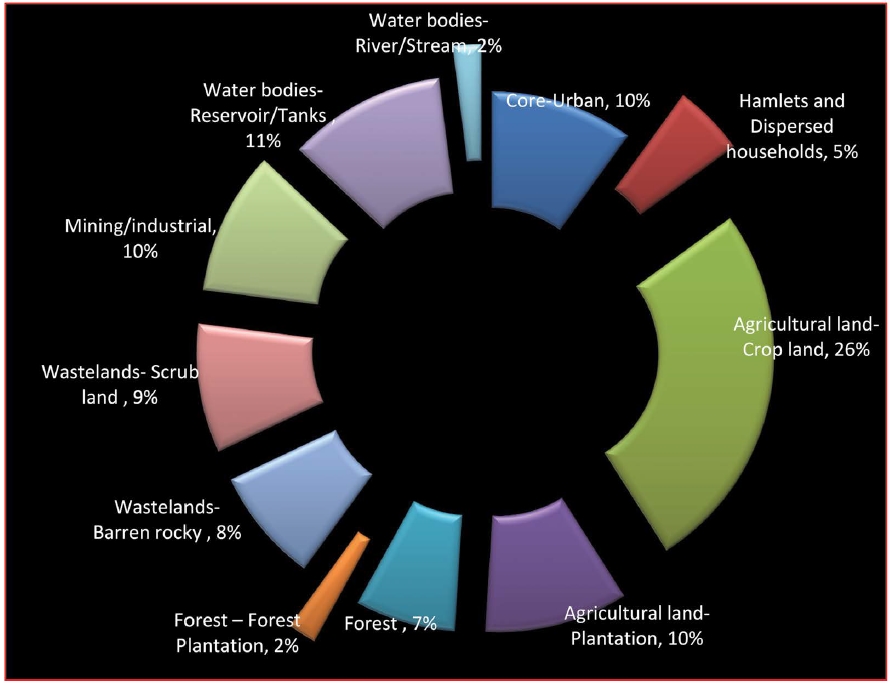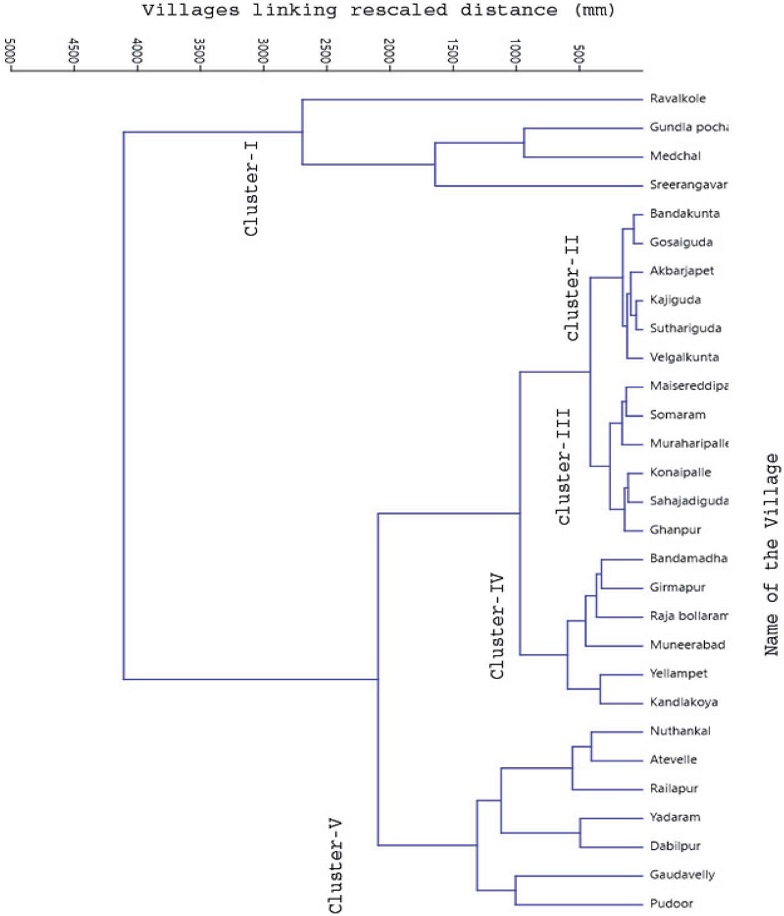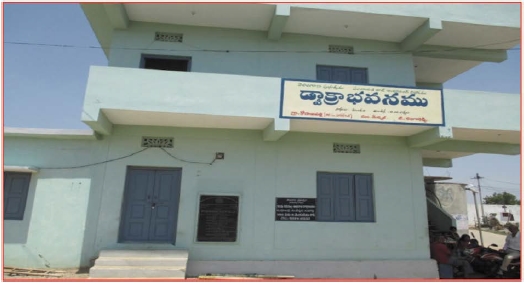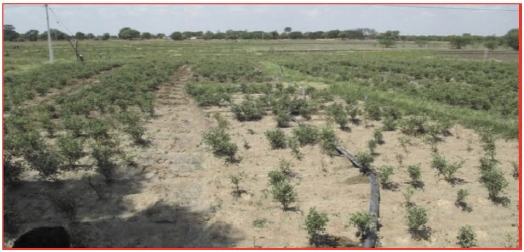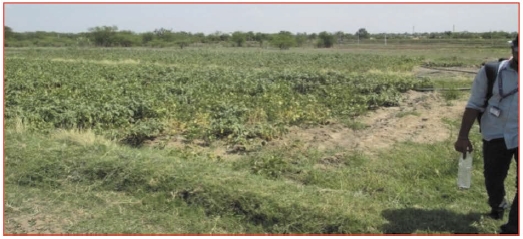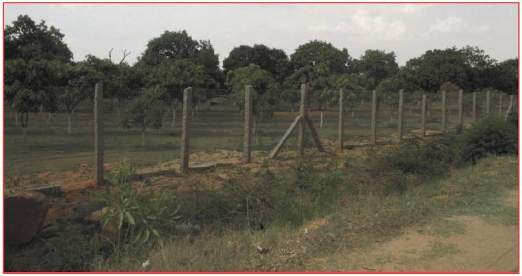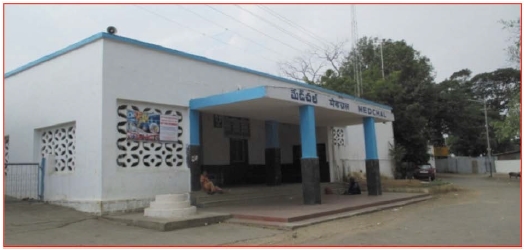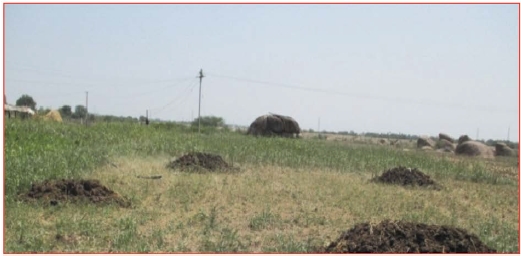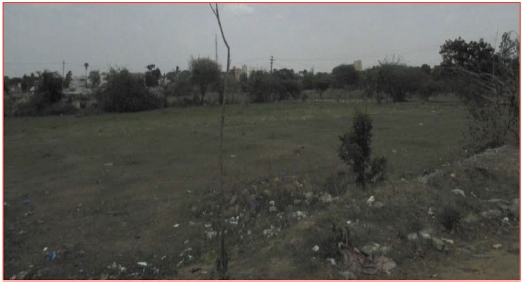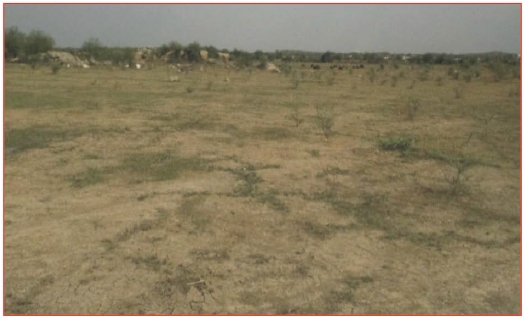
Subcategories Multiple Uses of Land Recognized by Land Use and Land Cover Classification System Using LISS-III and NRSC Enumerate Data: Case Study at Medchal Mandal, Hyderabad, India
Copyright © 2020 by Asian Association for Atmospheric Environment
This is an open-access article distributed under the terms of the Creative Commons Attribution Non-Commercial License (http://creativecommons.org/licenses/by-nc/4.0/), which permits unrestricted non-commercial use, distribution, and reproduction in any medium, provided the original work is properly cited.
Abstract
Recognition of compound land possessions in Mandal level often produces complex in precisely classifying land use and land cover (LULC) characteristics. A renovated village, as an Infrastructure development ought to adequate information on several aspects of its performance in direct to compose verdict. LULC is merely a solitary such aspect, to increase significance to conquer problems of declining environmental quality, farmlands, degradation of wetlands, the slaughter of wildlife territory, and water bodies. LISS-III (Linear Integrated self-scanning) images and NRSC (National Remote Sensing Centre) catalog improve LULC classification accuracy at the Mandal level. The results of this investigation reveal that five categories are occupied a large area, followed by build-up land, cropland, forest, industries, and water bodies, (13%, 26%, 9%, 10%, and 13%). The highest contribution is cropland and the lowest contribution is forest land. The unobstructedly available a large amount of satellite data conceding for monitoring of existing land features on a large scale. Cluster-I division contains more dominated LULC categorised villages such as Ravalkole, Gundlapochampally, Medchal, and Sreerangavam villages. LULC classification data applied for investigation of environmental sustainability and problems. This research has been recommended and support for implement rainwater harvesting structures for recharge of groundwater or collection of water in this Medchal Mandal and develop mobile education, higher education institutes, and small-scale industries in villages.
Keywords:
Land use and Land cover classification, Medchal Mandal, LISS-III image, NRSC LULC catalogue1. INTRODUCTION
As per population records, India is the second country in the world (1.32 billion). Telangana State stands at the 12th place for the population in India. Year by year the urban population increases because more people prefer to live in urban cities like Hyderabad. The development scenario in the fields of industrialization, infrastructure, transportation, accommodation, with high-income sources is only in such of these cosmopolitan cities (Zhang and Ro, 2017). The rapid and incessant growth of migrants in urban slum areas of large cities is creating continuous pressure on urban cities. It insists on major changes in ecosystems from purities to impurities. Modifications of land features/subtypes have accelerated after the industrial revolution, driven to obtain more resources to supply to a continuously growing population (Cihlar, 2000; Rosenfield and Fitzpatrick-Lins, 1986).
The land is referred in a holistic way as upper layer of the earth’s crust combined with the troposphere (plants, human), minerals, hydrology (lakes, rivers, ocean) and sediments (Anuraga et al., 2006; De Leeuw et al., 2006; Foody, 2002). The human settlement pattern and physical features are the results of past and present human activity, terracing, water storage or drainage structures, roads, buildings, etc. (Abdulhakim, 2019).
Land use defines the manual activities and settlement on the earth’s surface. It is managed and changed the environmental aspects. Land cover explains about vegetation, rocks, soils, surface water bodies. Land use is concluded based on the land cover only, land cover and land use both are similar but they are indistinguishable (Hermosilla et al., 2018; Di Gregorio and Jansen, 2004). Agricultural and animal flourishing put pressure on land increased by human demand. Vigorous action on the available land accordingly and continuous monitoring of land resources is necessary to know not just land features, but also the optimal study of land subtypes increases based on growing human population (Yeh and Li, 1998).
A GIS (Geographic Information System) is a discipline that helps to identify topographical features and is useful in many applications such as land use/land cover classification (LULC), determination of plantation in the forest area, marine features, urban planning, drainage network and transportation, etc. (Butusov, 2003; Houghton et al., 1999; Vitousek et al., 1997; Meyer and Turner, 1992).
Land use data analysis, preparation of thematic maps on different aspects such as road networks, agricultural, plantation and build-up land, will help to understand, problems to resolve environmental prospects of present and past. People migrate from rural to urban regions. Usually population, economy, basic amenities and resources increase in an urban region. Thematic map of build-up land explains urban sprawl development and direction (Hasse and Lathrop, 2003; Epstein et al., 2002; Torrens and Alberti, 2000). Cities have good infrastructure, industries, parks, theatres, etc., with good facilities that attracted more people from the last decade, most of the rural people were transported and settled in cities and accumulated a place (Zhao et al., 2019; Jat et al., 2008; Taubenbock, 2008). Town planning engineers have to prepare and design a town-planning map for future generations but a sudden increase in the urban population creates a lot of discrimination in vision and planning (Jaiswal et al., 2003). Advanced survey techniques of remote sensing will have to analyze census data and segregate the people as per vision (Oleksandr and Matthias, 2013; Weng and Lu, 2007).
The land which is outside the forest boundary and not utilized for cultivation is the land with or without shrubs is usually associated with shallow, stony, rocky other non-bearable lands (Chi et al., 2008). There are different techniques of classification used for detection of LULC. The methods are image comparison, classified images, raster classification, and system for automated geo-scientific analyses (SAGA) classification (Green et al., 1994).
1. 1 Land Use/Land Cover Classification System
Remote sensing obtained data mostly preserved in 1 : 250,000 now it will be extended up to 1 : 25,000. There have been a lot of changes for implication during interpretation, to determine all features on the surface and distinguishing them in a proper manner is necessary (Weiss et al., 2020). For advanced survey techniques, in the year of 2006 National Remote Sensing Agency released a standard LULC mapping manual for supervising of the country’s natural resources (Ganasri and Dwarakish, 2015).
Earlier efforts to map the theme on 1 : 50,000 scale followed certain standards which required modifications in the current day’s context (Manual for geomorphological and lineament mapping, 2010). To this extent, an exhaustive topographical LULC classification was evolved to facilitate an in-depth assessment of all categories (Narasimha Rao et al., 2010; El-Raey et al., 2000). Categorization of geographical features assists to understand the present scenario of the land feature, which is compared to old data or make a vision for proper development of urbanization (Miao et al., 2017; Abdalla and Abdulaziz, 2012). The classification should be authorized scientifically through data applicable for all-regions and it should be monitored every year only after which desirable results come out (National Remote Sensing Agency, 2006).
Satellite images of IRS_P6 linear imaging self-scanning sensor LISS-III data is geometrically corrected within the framework of the National Natural Resources Management System (NNRMS). Specified standards are the primary inputs for classification and mapping. In agricultural fields, crop monitoring plays a major role. Multi-temporal and spectral data gathered in all three seasons such as Kharif (June-October), Rabi (December/January-February/March) and Zaid (April-May) are preserved into satellite imageries. This data has a good resource for calculation of crop area, growing or areas being damaged. GIS software is created layers for crop monitoring. These layers are comprised all the boundaries (village, Mandal, District, National, International, reserve forest and water bodies, etc.,) road networks, drainage networks, built-up area, wasteland and marine features (Prakasam, 2010; Clevers et al., 2004).
2. METHODOLOGY
Integration of LULC of Medchal Mandal compiles onscreen interpretation of thematic maps such as Transportation map (Fig. 1), drainage networks and water bodies map (Fig. 2) which are produced LULC thematic map by using GIS software, IRS_P6 LISS III (Path 24 and Row 61) imagery and Survey of India Toposheets (56 K/6 and 56 K/10 on 1 : 50,000 scale) are used for visual interpretation and ASTER DEM maps used to determine the drainage network, waterbodies, land elevation and geology of the area. NRSA standard LULC classification is used for the preparation of LULC map.
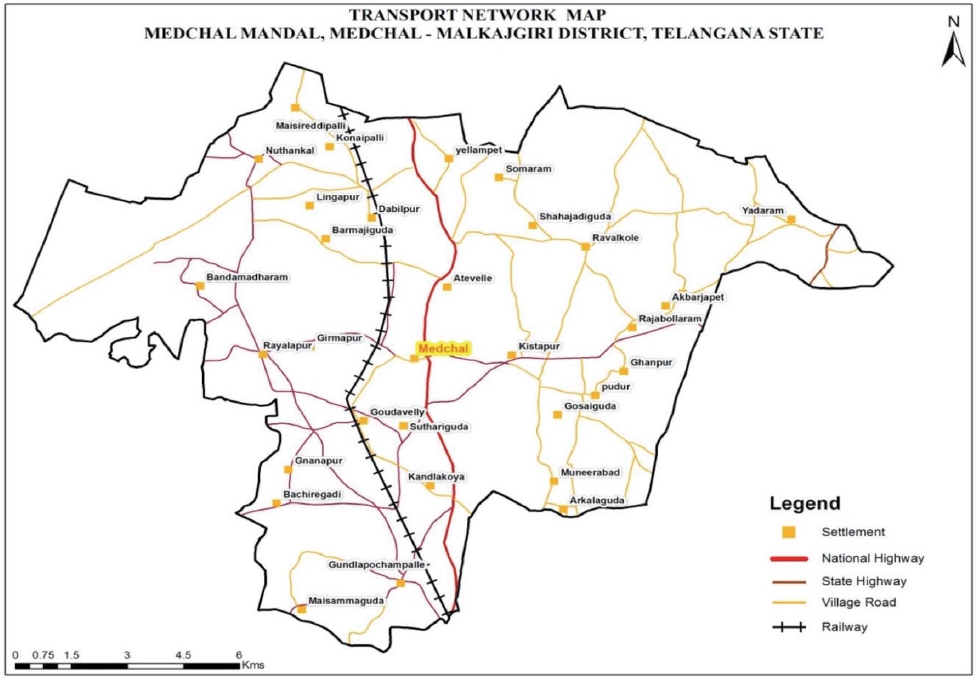
Transport network and Settlement Locations of Medchal Mandal, Medchal-Malkajgiri District, Telangana State.
Preparation of LULC thematic map of Medchal Mandal. Collected the SOI map at Survey of India office, Uppal, Hyderabad, and satellite data solicit from National Remote Sensing Centre, Hyderabad. The Topo-sheets scanned copies and satellite images were converted into digital mode. Geo-referenced Topo-sheets overlap on the satellite imagery and then distinct layers for the LULC is created with layers such as boundary, water bodies, transport, built-up land (Fig. 3). In the transport map, roads and road networks, drainage networks and streams are drawn by line command. Lakes, reserve forest, natural forest, and buildings are drawn by using polygon command.
2. 1 Land Use/Land Cover of Medchal Mandal
Medchal Mandal is located in NNE direction to Hyderabad with distance of 34 km in Telangana state (Fig. 4). The Medchal Mandal has 196.31 sq km of geographical area, for the analysis and segregation of LULC of the Medchal Mandal. Remote sensing techniques are the best method, in regards to LULC map prepared by Quantum geographical information system software. Ground truth data is also included for on-screen interpretation. In this scenario, the Medchal Mandal contains the 11 units of the LULC characteristics. Each category has an individual color determination for clear visibility.
LULC of Medchal Mandal is classified based on the Manual of National LULC mapping prepared by the National Remote Sensing Centre (NRSC, 2014). Using IRS-_P6 LISS-III satellite data and analyzed the data in Quantum GIS software. LULC of Medchal Mandal comprises the 11 broad categories (Fig. 5) such as
- 1. Core-urban
- 2. Hamlets and dispersed household
- 3. Agricultural land - crop land
- 4. Agricultural land - plantation
- 5. Forest
- 6. Forest plantation
- 7. Wastelands - Barren Rocky/Stony
- 8. Wastelands - Scrub land - Open scrub
- 9. Mining/Industrial
- 10. Waterbodies - Reservoir/Tanks
- 11. Waterbodies - River/Stream
2. 2 Core-urban
Core-urban division includes municipality, corporation, and cantonment, which are notified town areas and all other areas, which has 5000 minimum population, and out of which 75% of the male working population is nonagricultural (Maktav et al., 2005; Chen and Stow, 2003). Kistapur, Ravalkole, Atevelle, Gundlapochampalle, Medchal, Pudoor, Goudavelly, Kajiguda villages are in this category. This unit is observed near Ravalkole, Dabilpur, Pudoor, Sree Rangavaram, and Nuthankal, villages and has an aerial extent of 4736 acres which is 10 per cent to the total geographical area of the study area (Fig. 6). It comprises regions with widely used land resources covered by intensive use and structures. It includes residential, industrial, transportation, power, communications and isolated places such as mills, and quarries (Figs. S1a, S1b, S2a, and S2b). Shopping centers, parks, playgrounds, open spaces, and institutions.
2. 3 Hamlets and Dispersed Households
This category has occupied the less portion in this Medchal Mandal (Table 1). It includes all the requisite conditions and is basically an open land. Such areas are found either lying idle or associated with buildings and other related infrastructure facilities for recreation and sport (Yin et al., 2010; Herold et al., 2003). They include playgrounds, gardens, and parks areas. However, forest, water, wetlands, and barren lands are not within the parks or recreation areas. Kandlakoya village has a park name as “Oxygen Park” nearby the national highway ring road.

Percentage of land use/land cover data of Medchal Mandal, Medchal-Malkajgiri District, Telangana State.
In satellite imagery playgrounds appear in white to yellowish color, regular in shape, dispersed in pattern and are mostly associated with residential areas and/or institutions (Madhu et al., 2017; Food, 2008). Gardens/parks appear in red to brick red in color, small to medium in size, generally regular in shape, dispersed and associated with residential areas, adjacent to roads.
Educational institutions such as schools (Figs. S3 and S4), colleges, universities religious places, health centers, cantonment areas, government buildings, etc. (Figs. S5a, S5b, and S5c). All buildings and grounds that comprise the facility are included within the institutional unit. In education building point of view, Medchal Mandal has many institutes like Engineering colleges, Degree colleges, High Schools, Primary Government Schools, and Medical Colleges. Vegetation land has a different plantation in the Medchal Mandal (Figs. S6, S7, S8a, and S8b). This unit is observed near Ravalkole, Pudoor, Dabilpur, Raja bollaram, and Nuthankal villages and has an aerial extent of 2580 acres which is 5 percent to the total geographical area of the study area.
Transporting goods and material as a measure of accessibility and connectivity is called transportation. It includes railways, roads, etc. (Figs. S9 and S10). The linear features listed above appear in small width for roads, and narrow in case of the railway line, dark bluish green to light yellow in most of the cases and at times are seen associated with vegetation along with them. They are more prominently seen in plain areas, across water bodies, agricultural lands connecting settlements. The regions are well connected by bituminous roads. Southeastern railway lines are passing through in Medchal Mandal. Nehru outer ring road passes through (on NH - 65 towards Mumbai) Kandlakoya (on NH - 44 towards Nagpur) to Masireddipalle village.
2. 4 Agricultural Land - Crop Land
The farmlands are more suitable for cultivation. When capturing through satellite, the imagery shows a dark red color to light red shade (UNESCO, 1973). Irrigated areas depend on the three cropping seasons, which exist in India viz., Kharif (June/July-September/October), Rabi (November/December-February/March) and Zaid (April-May). It is a necessary pre-requisite to consult the crop season of an area. As the cropping year is highly region specific, before acquiring the satellite data to ensure meadow irrigation on the day of temporal resolution (Figs. S11, S12, S13a, and S13b) (Mathur and Foody, 2008). This unit is observed near Ravalkole, Yadaram, Dabilpur, Gaudavelly, Gundlapochampalle, Bandamadharam, and Yellampet villages and has an aerial extent of 12412 acres which is 26 per cent to the total geographical area of the study area.
2. 5 Agricultural Land - Plantation
In Telangana State, two crops dominate in agriculture. Kharif and Rabi, in that Kharif crop, is spread from June to October, with precipitation merely for growing the plants in dry-land farming, with limited or no irrigation and areas of rain-fed paddy and other dry crops. Second largest cultivation season is Rabi, extending between November/December-February/March. Black cotton soil is a major source for the growth of plantation in Rabi months. The cultivation depends on mainly groundwater resources. Some of the fields are cultivated on rainwater and canal (Rao et al., 2015; Oleksandr et al., 2012).
Medchal Mandal has 9% agricultural plantation, in that Ravalkole village (1006 acres land), Pudoor village (705 acres), Gundlapochampalle (512 acres), and Atevelle (500 acres), remaining villages have less land acquisition (Table 2). The main crops are, maize (Ravalkole, Raja bollaram, Gaudavelly), millets (Dabilpur, Ravalkole, and Bandamadharam) redgram (Raja bollaram and Ravolkole) pulses (Raja bollaram and Ravolkole) foodgrains (Dabilpur, Ravalkole and Pudoor) mangoes (Ravalkole, Pudoor and Raja bollaram) lime (Pudoor and Nuthankal) orange (Pudoor) grapes (Yadaram, Railpur and Pudoor) guava (Konaipalle, Medchal and Pudoor) papaya (Raja bolaram) pomegranate (Pudoor) Railapur and Ravalkole) dry fruits (Pudoor, Railapur and Ravalkole) brinjal (Gundlapochampalle, Pudoor) green leafy vegetables (Pudoor) cabbage (Gundlapochampalle) tomato (Pudoor and Gosaiguda) mirchi (Rayalapur and Kandlakoya) grass (Pudoor, Dabilpur, Ravalkole and Medchal). This unit is observed near Ravalkole, Pudoor, Gundlapochampalle, Atevelle, and Raja bollaram villages and has an aerial extent of 4654 acres which is 10 percent to the total geographical area of the study area.
2. 6 Forest
The land which consists of a huge accumulation of trees, shrubs, grass, herbs and mosses growing at a permanent position and includes animals is known as a forest. This region is capable of producing food, water, fuel and timber (Song et al., 2011; Sreenivas and Roy, 2008). Medchal Mandal Forest regions namely Medchal reserve forest, Pochampalle reserve forest, Goudavelly reserve forest, Dabilpur reserver forest, Bandamadaram reserve forest, Kandlakoya reserve forest, Masjidpur reserve forest, Raja bollaram reserve forest and Konaipalle forest. The coniferous forest has a thick and dense canopy of towering trees predominantly leftover green throughout the year. These forests exhibit red color progress in varying sizes, smooth to a coarse texture on crown density, contiguous to non-contiguous in a pattern based on their location (Khatami et al., 2016). Generally, these forests occupy high relief areas receiving heavy rainfall. This unit is observed near Gundlapochampalle, Dabilpur, Bandamadaram, Kandlakoya and Raja bollaram villages and has an aerial extent of 3275 acres which is 7 per cent to the total geographical area of the study area.
2. 7 Forest Plantation
The place is filled with uniform plantation and patterns and includes different plant bodies such as eucalyptus and pine. The forest of canopy shades and row patterns are the evidence (Franklin, 2001). In the graphical representation, 2% is shown within the total area of the Medchal Mandal. Forest plantation villages are Yadaram, Ravalkole, Yellampet, Dabilpur, Gaudavelly, Gundlapochampalle, Kandlakoya and Medchal. This unit is observed near Gundlapochampalle, Dabilpur, Bandamadaram, Kandlakoya, and Raja bollaram villages and has an aerial extent of 1195 acres which is 2 per cent to the total geographical area of the study area.
2. 8 Wastelands - Barren Rocky/Stony Waste
In this category, rock materials have spread over the surface and separated from soil and vegetation cover. These lands have different color exposures for that easy to distinguish the distinct surface features (NRSA, 2007; Townshend, 1992). Remote sensing technology has an excellent facility to separate the categories which are present on the surface based on characteristics of the spectral resolution of imageries (Smits et al., 1999). Enhancing the different colors mainly depends on geology, weathering of rock, grain sizes, structures, textures, and shapes, etc. Medchal Mandal has good resources of granite, weathered soil and barren lands (Figs. S14a, S14b, and S14c). Girmapur village has more boulders. This unit is observed near Ravalkole, Medchal, Bandamadharam, and Nuthankal, villages and has an aerial extent of 3900 acres which is 8 per cent to the total geographical area of the study area.
2. 9 Wastelands - Scrub Land/Open Scrub
Scrubland is a land which is generally prone to deterioration due to erosion (Georganos et al., 2018; Coppin et al., 2004). Such lands generally occupy topographically high locations. In satellite imagery it looks light yellow to brown in color, if moisture is combined with scrubland then it shows in greenish blue color. The structure of this category appears continuous or of spilled pattern and is located in flatted hilly terrain, the bottom of a mountain, or a moderate slope region. This unit is observed near Bandamadharam, Gaudavelly, Nutankal, Maisereddipalle, Yellampet and Railpur villages and has an aerial extent of 4217 acres which is 9 per cent to the total geographical area of the study area.
2. 10 Mining/Industrial
This division has the extraction of earth material (both surface and subsurface), either manual or mechanized. Open cast mining and underground mining explicitly source earth material and unsourced material, unsourced material such as weathered rocks, loose soil, etc., which are economically unimportant are used for dumping in wasteland areas. In this division, Medchal Mandal has few mining areas namely Ghanpur village and Muneerbad village. Quartz and sand dust open cast mining is under process (Figs. S15, S16, and S17). This unit is observed near Railpur, Gaudavelly, Gundlapochampalle, Medchal, Pudoor, Nuthankal, Ravalkole, Athvelle, Girmapur, Yellampet, and Sree rangavaram, villages and, has an aerial extent of 4983 acres which is 10 per cent to the total geographical area of the study area.
2. 11 Waterbodies - Reservoir/Tanks
These are an accumulation of water bodies in a land depression region which is either natural or man-made, like ponds and tanks (Amee et al., 2017). This Medchal Mandal has different tanks and tributaries which are interconnected. This unit is observed near Nuthankal, Ravalkole, Medchal, Atevelle, and Pudoor villages and has an aerial extent of 5467 acres which is 11 per cent to the total geographical area of the study area.
2. 12 Waterbodies - River/Stream
In this category, the feature consists are surface water, ponds, lakes, and reservoirs or flowing as streams, rivers, and canals, etc. These are seen clearly in the satellite image in blue to dark blue or cyan color depending on which contain sediment in water (Fernández-Prieto, 2002; Swain and Davis, 1978). This Medchal Mandal has different lakes and tributaries which are interconnected. This unit is observed near Sree Rangavaram, Ravalkole, Medchal, Atevelle and Pudoor villages and has an aerial extent of 1078 acres which is 2 percent to the total geographical area of the study area.
3. RESULTS AND DISCUSSION
Medchal Mandal has divided into eleven categories of LULC areas, using remote sensing and GIS techniques. It provides a good understanding of the topographic features. LULC combined with GIS produces high-quality maps that will be helpful for future generations through easy to understand recent scenarios (Goodin et al., 2015; DeFries and Chan, 2000).
Built-up land includes hospitals, houses, shops, complexes, and apartments, etc. The buildings in Medchal Mandal are constructed with concrete material instead of sand. The availability of sand is very less portion in this Medchal Mandal for that civil engineers preferred to use stone dust. Stone dust mines also are available in this Medchal Mandal and it’s surroundings.
Medchal Mandal has 48,510 acres of land and in that cropland occupies 12,312 acres. Pudoor and Ravalkole villages have a major portion of cropland, and Velgalkunta, Akbarjapet, Kaziguda, and Suthariguda villages have less portion. Medchal Mandal has cropland of 26% and is shown in the graphical representation. People have to acquire awareness to develop cropland.
Uncultivated lands, barren land, boulder region and wastelands are about 3272 acres in this Medchal Mandal. Some of the wastelands converted into anthropogenic activity areas. Dangerous toxic chemicals have accumulated in anthropogenic area, therefore natural resources especially aquifers are polluted at a high level. Anthropogenic activity villages are Girmapur, Gosaiguda, Ghanpur, Ravalkole, and Kandlakoya.
Medchal Mandal has an adverse stage of surface water resources. Most of the lake’s water is filled with rainwater only. The lakes become dry when scarce rainfall takes place. Few of the region’s lakes have been taken over for building apartments, cultivation lands, and other purposes. Reservoir and lakes have 5,136 acres land, 112 lakes are located in and around the national highway ring road and lakes are interconnected with each other, while water flows in the northeast direction depending on the slope. Village wise LULC classification categorised by Cluster analysis, Cluster-I 4 villages are more dominated in all sectors, Cluster-II and Cluster-III villages have near by equal priority at lowest level division, Cluster-V villages less below dominate compare to Cluster-I viallages and Cluster-IV villages have moderate by remain clusters (Fig. 7).
4. SUMMARY AND CONCLUSION
Medchal Mandal is located in Medchal-Malkajgiri District of Telangana State. It is present in the northeastern part of Hyderabad region. The study area has 196 sq km area at a distance of 35 km from Hyderabad city. Medchal Mandal has an annual average rainfall of 848 mm. The population in this Madal is rapidly growing as most business people are interested to invest and establish the industries in this region.
The geology of the area has hard compacted nature with peninsular gneissic complex of Archean age. This rock type has predominantly granite and alkali feldspar granite rock. Medchal Mandal lies in the North East direction of Hyderabad, it is an Industrial sub hub and District headquarters’ of the Medchal-Malkajgiri region Telangana State, India. Major industries, mining areas, Medical colleges, and Engineering colleges have existed here. As such from the observation of water conditions the quality of water in 60% of the villages is good but in 40% of the villages is in a very bad condition.
Medchal Mandal normal rainfall is 835.7 mm. Rain drained from southwest monsoon and it’s covers the area between June and September months. It starts from the north Kerala State and enters into the Hyderabad regions.
Recharge of groundwater is essential for Medchal Mandal because of groundwater level. Rainfall and surface water bodies are not sustained the socio-economical values. Each individual houses, industries, parks, commercial buildings, and education institutes have to implement rainwater harvesting structures for recharge of groundwater or collection of water.
LULC of Medchal Mandal comprises the 11 broad categories, which covers 196.3 sq.km. in this five division are occupied large area, followed by build-up land, cropland, forest, industries, and water bodies, with percentage 13%, 26%, 9%, 10%, and 13%. The study area dominated by the industries. The highest contribution is cropland and the lowest contribution is forest land. Cluster-I division have more dominated villages such as Ravalkole, Gundlapochampally, Medchal, and Sreerangavam villages. Cluster-V have 7 villages in second place remain 3 clusters have low to moderate in all LULC sectors.
Medchal Mandal has an adverse stage of water resources. Most of the lake’s water is filled with rainwater only. Medchal Mandal has different lakes and tributaries which are interconnected. The lakes become dry when scarce rainfall takes place. Few of the region’s lakes have been taken over for building apartments, cultivation lands, and other purposes. Suggestion from in this study, that the government initiates mobile education, higher education institutes, and small-scale industries in villages Muraharipalle, Gosaiguda, Maisereddipalle, Konaipalle, Shahajadiguda, Somaram, Ghanpur, Suthariguda, Railapur, Yadaram, Bandamadharam, Muneerabad, Nuthankal, Girmapur, and Yellampet for healthy development.
CONFLICTS OF INTEREST
The authors declare that they have no conflict of interest.
ETHICAL APPROVAL
This article does not contain any studies with human participants or animals performed by the authors.
INFORMED CONSENT
For this type of study, formal consent is not required.
References
-
Abdalla M.F., Abdulaziz M.A. (2012) Monitoring land-use change-associated land development using multitemporal Landsat data and geoinformatics in Kom Ombo area, South Egypt. International Journa of Remote Sensing, 33(22), 7024-7046.
[https://doi.org/10.1080/01431161.2012.697207]

-
Abdulhakim M.A. (2019) Land cover and land use classification performance of machine learning algorithms in a boreal landscape using Sentinel-2 data. GIScience and Remote Sensing, 57(1), 1-20.
[https://doi.org/10.1080/15481603.2019.1650447]

-
Amee, K.T., Venkappayya, R.D., Ajay, Patel., Madhukar, B.P. (2017) Post-classification corrections in improving the classification of Land Use/Land Cover of arid region using RS and GIS: The case of Arjuni watershed, Gujarat, India. The Egyptian Journal of Remote Sensing and Space Scinece, 20(1), 79-89.
[https://doi.org/10.1016/j.ejrs.2016.11.006]

-
Anuraga, T.S., Ruiz, L., Mohan Kumar, M.S., Sekhar, M., Leijnse, A. (2006) Estimating groundwater recharge using land use and soil data: a case study in South India. Agriculture Water Management, 84, 65-76.
[https://doi.org/10.1016/j.agwat.2006.01.017]

-
Butusov, O.B. (2003) Textural classification of forest types from Landsat 7 imagery. Mapping Sciences and Remote Sensing, 40, 91-104.
[https://doi.org/10.2747/0749-3878.40.2.91]

-
Chen, D., Stow, D.A. (2003) Strategies for integrating information from multiple spatial resolutions into land‐use/land-cover classification routines. Photogrammetric Engineering and Remote Sensing, 69, 1279-1287.
[https://doi.org/10.14358/PERS.69.11.1279]

-
Chi, M., Feng, R., Bruzzone, L. (2008) Classification of Hyperspectral Remote-sensing Data with Primal SVM for Small-sized Training Dataset Problem. Advances in Space Research, 41(11), 1793-1799.
[https://doi.org/10.1016/j.asr.2008.02.012]

-
Cihlar, J. (2000) Land cover mapping of large areas from satellites: status and research priorities. International Journal of Remote Sensing, 21(6-7), 1093-1114.
[https://doi.org/10.1080/014311600210092]

- Clevers, J.G.P.W., Bartholomeus, H., Mücher, C.A., Wit, A.J.W. De. (2004) Land Cover Classification with the Medium Resolution Imaging Spectrometer (MERIS). EARSeL eProceedings, 3(3), 354-362. https://library.wur.nl/WebQuery/wurpubs/fulltext/139566
-
Coppin, P., Jonckheere, I., Nackaerts, K., Muys, B., Lambin, E. (2004) Digital change detection methods in ecosystem monitoring: A review. International Journal of Remote Sensing, 25(9), 1565-1596.
[https://doi.org/10.1080/0143116031000101675]

-
DeFries, R.S., Chan, J.C. (2000) Multiple criteria for evaluating machine learning algorithms for land cover classification from satellite data. Remote Sensing of Environment, 74, 503-515.
[https://doi.org/10.1016/S0034-4257(00)00142-5]

-
De Leeuw, J., Jia, H., Yang, L., Liu, X., Schmidt, K., Skidmore, A.K. (2006) Comparing Accuracy Assessments to Infer Superiority of Image Classification Methods. International Journal of Remote Sensing, 27(1), 223-232.
[https://doi.org/10.1080/01431160500275762]

- Di Gregorio, A., Jansen, L.J.M. (2004) Land Cover Classification System. Classification Concepts and User Manual, version 2, United Nations Food and Agriculture Organization, Rome. http://www.fao.org/3/y7220e/y7220e00.htm
-
El-Raey, M., Fouda, Y., Gal, P. (2000) GIS for environmental assessment of the impacts of urban encroachment on Rosetta region, Egypt. Environmental Monitoring and Assessment, 60(2), 217-233. https://link.springer.com/article/10.1023/A:1006195006898
[https://doi.org/10.1023/A:1006195006898]

- Epstein, J., Payne, K., Kramer, E. (2002) Techniques for mapping suburban sprawl. Photogrammetric Engineering & Remote Sensing, 63(9), 913-918. https://home.cis.rit.edu/~cnspci/references/epstein2002.pdf
-
Fernández‐Prieto, D. (2002) An iterative approach to partially supervised classification problems. International Journal of Remote Sensing, 23, 3887-3892.
[https://doi.org/10.1080/01431160210133563]

-
Foody, G.M. (2002) Status of land cover classification accuracy assessment. Remote Sensing of Environment, 80, 185-201.
[https://doi.org/10.1016/S0034-4257(01)00295-4]

-
Foody, G.M. (2008) RVM-based multi-class classification of remotely sensed data. International Journal of Remote Sensing, 29, 1817-1823.
[https://doi.org/10.1080/01431160701822115]

-
Franklin, S.E. (2001) Remote Sensing for Sustainable Forest Management. Lewis Publishers, Boca Raton, 407pp.
[https://doi.org/10.1201/9781420032857]

-
Ganasri, B.P., Dwarakish, G.S. (2015) Study of Land use/land Cover Dynamics through Classification Algorithms for Harangi Catchment Area, Karnataka State, INDIA. Aquatc Procedia, 4, 1413-1420.
[https://doi.org/10.1016/j.aqpro.2015.02.183]

-
Georganos, S., Grippa, T., Vanhuysse, S., Lennert, M., Shimoni, M., Wolff, E. (2018) Very High Resolution Object-Based Land Use-Land Cover Urban Classification Using Extreme Gradient Boosting. IEEE Geoscience and Remote Sensing Letters 15(4), 607-611.
[https://doi.org/10.1109/LGRS.2018.2803259]

-
Goodin, D.G., Anibas, K.L., Bezymennyi, M. (2015) Mapping Land Cover and Land Use from Object-based Classification: An Example from a Complex Agricultural Landscape. International Journal of Remote Sensing, 36(18), 4702-4723.
[https://doi.org/10.1080/01431161.2015.1088674]

- Green, K., Kempka, D., Lackey, L. (1994) Using remote sensing to detect and monitor land-cover and land-use change. Photogrammetric Engineering and Remote Sensing, 60, 331-337. https://www.asprs.org/wp-content/uploads/pers/1994journal/mar/1994_mar_331-337.pdf
-
Hasse, J.E., Lathrop, R.G. (2003) Land resource impact indicators of urban sprawl’. Applied Geography, 23(3) 159-175.
[https://doi.org/10.1016/j.apgeog.2003.08.002]

-
Hermosilla, T., Wulder, M.A., White, J.C., Coops, N.C., Hobart, G.W. (2018) Disturbance-informed Annual Land Cover Classification Maps of Canada’s Forested Ecosystems for a 29-year Landsat Time Series. Canadian Journal of Remote Sensing, 44(1), 67-87.
[https://doi.org/10.1080/07038992.2018.1437719]

-
Herold, M., Goldstein, N.C., Clarke, K.C. (2003) The spatiotemporal form of urban growth: Measurement, analysis and modeling. Remote Sensing of Environment, 86, 286-302.
[https://doi.org/10.1016/S0034-4257(03)00075-0]

-
Houghton, R.A., Hackler, J.L., Lawrence, K.T. (1999) The U.S. carbon budget: contribution from land-use change. Science, 285, 574-578.
[https://doi.org/10.1126/science.285.5427.574]

-
Jaiswal, R.K., Mukherjee, S., Krishnamurthy, J., Saxena, R. (2003) Role of remote sensing and GIS techniques for generation of groundwater prospect zones towards rural development: an approach. International Journal of Remote Sensing, 24(5), 993-1008.
[https://doi.org/10.1080/01431160210144543]

-
Jat, M.K., Garg, P.K., Khare, D. (2008) Monitoring and modeling of urban sprawl using remote sensing and GIS techniques. International Journal of Applied Earth Observation and Geoinformation, 10(1), 26-43.
[https://doi.org/10.1016/j.jag.2007.04.002]

-
Khatami, R., Mountrakis, G., Stehman, S.V. (2016) A Meta-analysis of Remote Sensing Research on Supervised Pixel-based Land-cover Image Classification Processes: General Guidelines for Practitioners and Future Research. Remote Sensing of Environment, 177, 89-100.
[https://doi.org/10.1016/j.rse.2016.02.028]

-
Madhu, T., Kumar, D.N., Reddy, D.N., Teja, P.V.E.R., Narayana, L., Vishal, V., Subash, B., Maniratnam, A., Vasavi, Y., Shakeena, V. (2017) Spatial-Temporal Analysis of LU/LC Classification in Nirmal Mandal, Adilabad, Telangana State, India, by Using Remote Sensing and GIS. International Journal of Geosciences, 8, 1315-1331.
[https://doi.org/10.4236/ijg.2017.811076]

-
Maktav, D., Erbek, F.S., Jürgens, C. (2005) Remote sensing of urban areas. International Journal of Remote Sensing, 26(4), 655-659.
[https://doi.org/10.1080/01431160512331316469]

-
Miao, L., Shuying, Z., Bing, Z., Shanshan, L., Chang, S.W. (2017) A Review of Remote Sensing Image Classification Techniques: the Role of Spatio-contextual Information. European Journal of Remote Sensing, 47(1), 389-411.
[https://doi.org/10.5721/EuJRS20144723]

- Manual for national geomorphological and lineament mapping on 1 : 50,000 scale. First edition, 2010 A project under national (natural) resources census (NRC). National remote sensing centre, Hyderabad. 1-150. https://www.researchgate.net/publication/284020063
-
Mathur, A., Foody, G.M. (2008) Crop classification by support vector machine with intelligently selected training data for an operational application. International Journal of Remote Sensing, 29, 2227-2240.
[https://doi.org/10.1080/01431160701395203]

-
Meyer, W.B., Turner II, B.L. (1992) Human Population growth and global land-use/Cover Change. Annual Review of Ecology and Systematics, 23, 39-61.
[https://doi.org/10.1146/annurev.es.23.110192.000351]

-
Narasimha Rao, P.V., Sesha Sai, M.V.R., Sreenivas, K., Krishna Rao, M.V., Rao, B.R.M., Dwivedi, R.S., Venkataratnam, L. (2010) Textural analysis of IRS-1D panchromatic data for land cover classification. International Journal of Remote Sensing, 23, 3327-3345.
[https://doi.org/10.1080/01431160110104665]

- NRSA (2007) Manual of National Wastelands Monitoring Using Multi‐temporal Satellite Data, Department of Space, Hyderabad. https://bhuvan-app1.nrsc.gov.in/2dresources/thematic/LULC250/0506.pdf
- NRSC (2014) Land Use/Land Cover database on 1 : 50,000 scale, Natural Resources Census Project, LUCMD, LRUMG, RSAA, National Remote Sensing Centre, ISRO, Hyderabad. https://bhuvan-app1.nrsc.gov.in/2dresources/thematic/2LULC/lulc1112.pdf
-
Oleksandr, K., Matthias, L., Diana, R. (2012) Texture-based identification of urban slums in Hyderabad, India using remote sensing data, Applied Geography, 32(2), 660-667.
[https://doi.org/10.1016/j.apgeog.2011.07.016]

-
Oleksandr, K., Matthias, L. (2013) Automated detection of slum area change in Hyderabad, India using multitemporal satellite imagery. ISPRS Journal of Photogrammetry and Remote Sensing, 83, 130-137.
[https://doi.org/10.1016/j.isprsjprs.2013.06.009]

-
Rao, C.V., Malleswara Rao, J., Senthil Kumar, A., Lakshmi, B., Dadhwal, V.K. (2015) Expansion of LISS III swath using AWiFS wider swath data and contourlet coefficients learning. GIScience and Remote Sensing, 52(1), 78-93.
[https://doi.org/10.1080/15481603.2014.983370]

- Rosenfield, G.H., Fitzpatrick-Lins, K. (1986) A Coefficient of Agreement as a Measure of Thematic Classification Accuracy. Photogrammetric Engineering and Remote Sensing, 52(2), 223-227. https://www.asprs.org/wp-content/uploads/pers/1986journal/feb/1986_feb_223-227.pdf
-
Smits, P.C., Dellepiane, S.G., Schowengerdt, R.A. (1999) Quality Assessment of Image Classification Algorithms for Land-cover Mapping: A Review and A Proposal for A Cost-based Approach. International Journal of Remote Sensing, 20(8), 1461-1486.
[https://doi.org/10.1080/014311699212560]

-
Song, K.S., Wang, Z.M., Liu, Q.F., Liu, D.W., Ermoshin, V.V., Ganzei, S.S., Zhang, B., Ren, C.Y., Zeng, L.H., Du, J. (2011) Land Use/Land Cover (LULC) Classification with MODIS Time Series Data and Validation in the Amur River Basin. Geography and Natural Resources, 32, 9-15.
[https://doi.org/10.1134/S1875372811010021]

-
Sreenivas, K., Roy, P.S. (2008) Land use land cover classification of Orissa using multi-temporal IRS-P6 awifs data: A decision tree approach. International Journal of Applied Earth observation and Geoinformation, 1(2), 186-193.
[https://doi.org/10.1016/j.jag.2007.10.003]

- Swain, P.H., Davis, S.M. (1978) Remote Sensing: The Quantitative Approach. McGraw-Hill, New York.
-
Taubenbock, H., Wegmann, M., Roth, A., Mehl, H., Dech, S. (2008) Urbanization in India - Spatiotemporal analysis using remote sensing data. Computers, Environment and Urban Systems, 33, 179-188.
[https://doi.org/10.1016/j.compenvurbsys.2008.09.003]

- Torrens, P.M., Alberti, M. (2000). Measuring sprawl. Working paper no.27 Association of Collegiate Schools of Planning Conference, November 2000. https://discovery.ucl.ac.uk/id/eprint/1370/1/paper27.pdf
-
Townshend, J.R.G. (1992) Land cover. International Journal of Remote Sensing, 13, 1319-1328.
[https://doi.org/10.1080/01431169208904193]

- UNESCO. (1973) International Classification and Mapping of Vegetation. Paris.
-
Vitousek, P.M., Mooney, H.A., Lubchenco, J., Melillo, J.M. (1997) Human domination of earth’s ecosystems. Science, 277, 494-499.
[https://doi.org/10.1126/science.277.5325.494]

-
Weiss, M., Jacob, F., Duveiller, G. (2020) Remote sensing for agricultural applications: a meta-review. Remote Sensing of Environment, 236, 1-20.
[https://doi.org/10.1016/j.rse.2019.111402]

-
Weng, D, Lu, Q. (2007) A survey of image classification methods and techniques for improving classification performance. International Journal of Remote Sensing, 28(5), 823-870.
[https://doi.org/10.1080/01431160600746456]

-
Li, X., Yeh, A.G.O. (1998) Principal component analysis of stacked multi-temporal images for the monitoring of rapid urban expansion in the Pearl River. International Journal of Remote Sensing, 19(8), 1501-1518.
[https://doi.org/10.1080/014311698215315]

-
Yin, J., Yin, Z., Zhong, H., Shuyuan, X., Xiaomeng, H., Jun W., Jianping, W. (2010) Monitoring urban expansion and land use/land cover changes of Shanghai metropolitan area during the transitional economy (1979-2009) in China. Environ Monit Assess., 177, 609-621.
[https://doi.org/10.1007/s10661-010-1660-8]

-
Zhang, H.K., Roy, D.P. (2017) Using the 500 M MODIS Land Cover Product to Derive a Consistent Continental Scale 30 M Landsat Land Cover Classification. Remote Sensing of Environment, 197, 15-34.
[https://doi.org/10.1016/j.rse.2017.05.024]

-
Zhao, B., Ping, T., Jun, Y. (2019) Land-cover classification from multiple classifiers using decision fusion based on the probabilistic graphical model. International Journal of Remote Sensing, 40(12), 4560-4576.
[https://doi.org/10.1080/01431161.2019.1569785]

Appendix
SUPPLEMENTARY MATERIALS
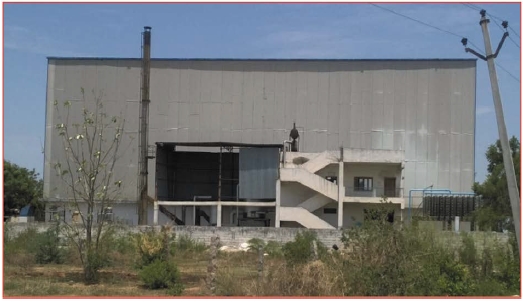
Cold storage factory in Kandlakoya village, Medchal Mandal, Medchal-Malkajgiri District, Telangana State.
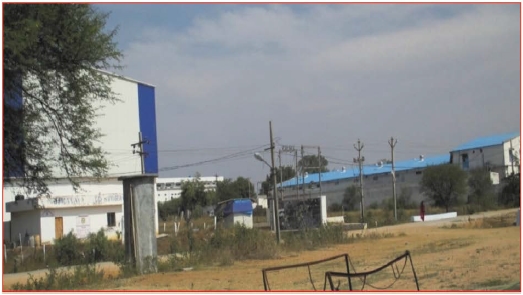
Cold Storage Factories in Somaram Village, Medchal Mandal, Medchal-Malkajgiri District, Telangana State.

Ceramic Factory in Raja bollaram village, Medchal Mandal, Medchal-Malkajgiri District, Telangana State.

Ceramic Factory in Raja bollaram village, Medchal Mandal, Medchal-Malkajgiri District, Telangana State.
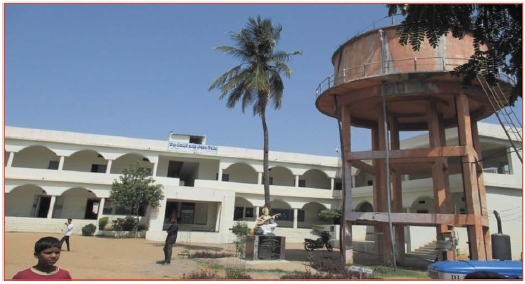
District High school in Goudavelly village, Medchal Mandal, Medchal-Malkajgiri District, Telangana State.
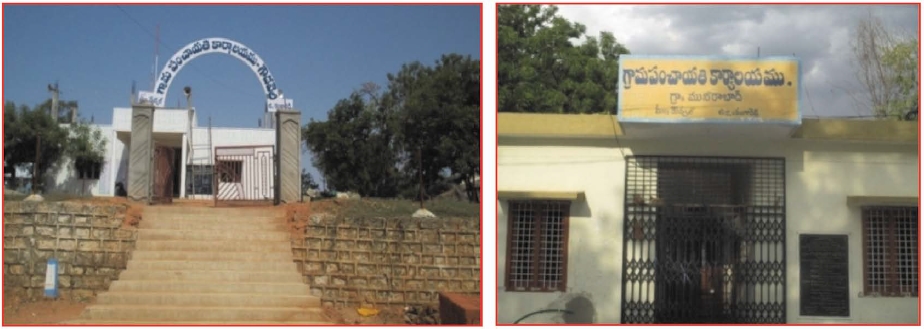
Panchayat offices of Goudavelly and Muneerabad villages in Medchal Mandal, Medchal-Malkajgiri District, Telangana State.
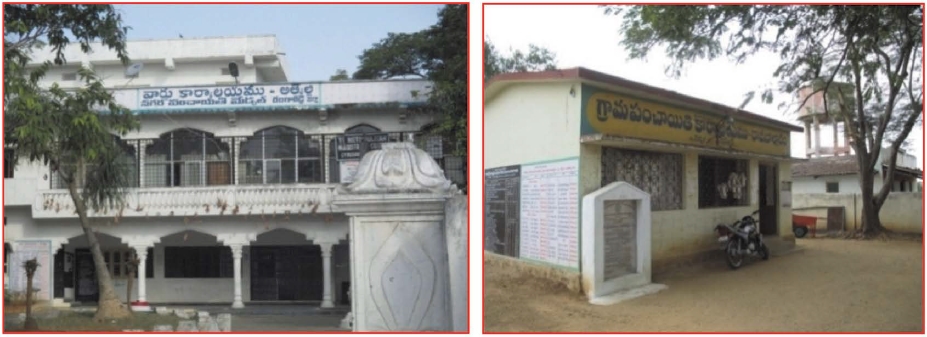
Panchayat offices of Atevelle and Raja bollaram villages in Medchal Mandal, Medchal-Malkajgiri District, Telangana State.

Panchayat offices of Gundlapochampalle and Pudoor villages in Medchal Mandal, Medchal-Malkajgiri District, Telangana State.
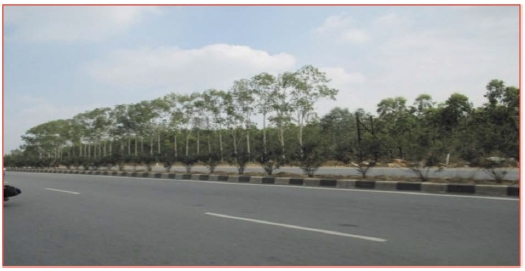
Nehru Outer Ring Road & Radial Roads beside good growth large trees in Medchal Mandal, Medchal-Malkajgiri District, Telangana State.

Kharif cultivated harvesting land in Maisereddipalle village, Medchal Mandal, Medchal-Malkajgiri District, Telangana State.
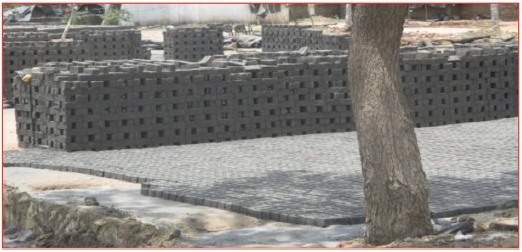
Cement bricks preparation in Somaram village, Medchal Mandal, Medchal-Malkajgiri District Telangana State.





